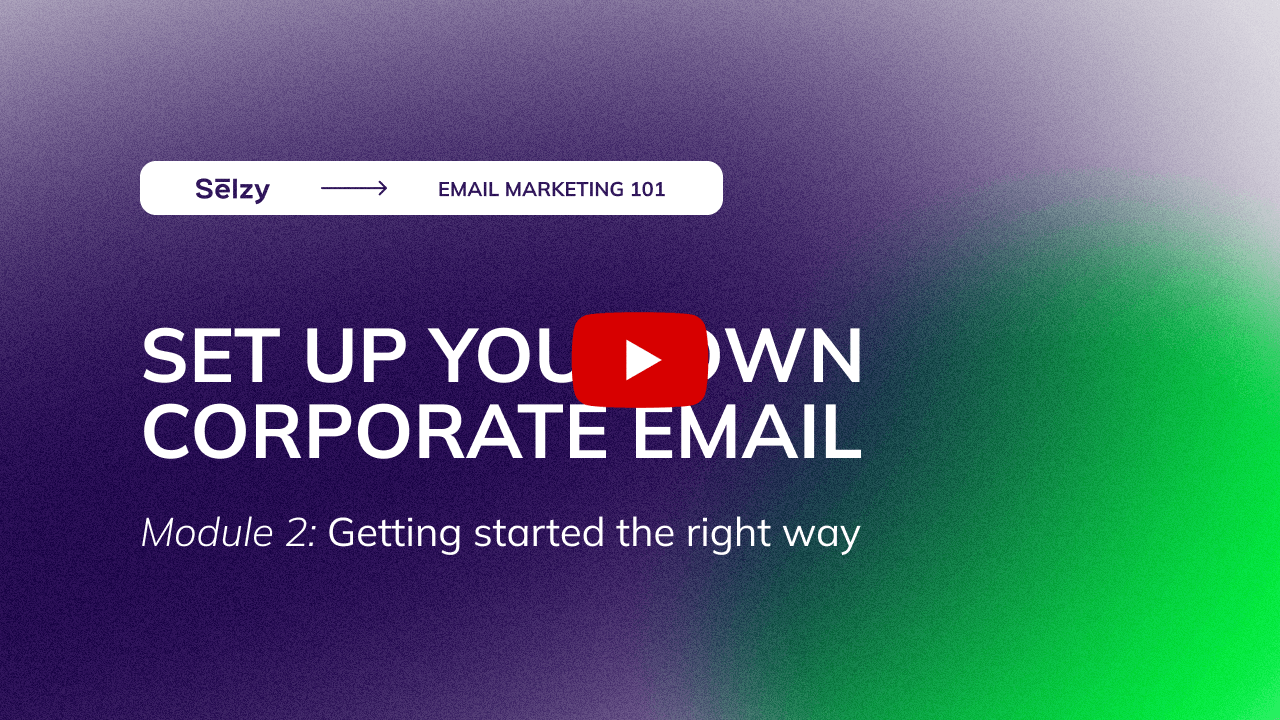How To Set Up Your Own Email For Sending
This is a transcript of lesson 4 of Email Marketing 101 Course by Selzy.

Hello and welcome back to our course on email marketing! In module 2, we discuss why sending emails from a free email account is a bad idea and what you should do instead for efficient email marketing campaigns.
Basically, if you send bulk emails from a free domain like @gmail or @outlook, it triggers spam filters. You should set up your own dedicated domain instead. That’s what we’ll talk about today.
Let’s start with a little reminder, though.
What is dedicated email domain?
A domain is the part of the email address that comes after the @, for example @selzy.com. Free email services offer shared domains like @gmail.com — many people have addresses with this part.
When you get a dedicated domain, only you can send emails from this address.
Setting up a dedicated email ensures that your campaigns end up in the “good” folder. It also looks more trustworthy to subscribers. Seeing your company’s domain in the “from” section will push them to open the email.
Even if you have a small business, a dedicated email is a must-have. Plus, you can create it yourself.
How to set up dedicated email domain?
To set up your corporate email, you’ll have to follow these 3 steps:
Buy a domain and create your corporate email
Register the domain with an email marketing platform
Set up authentication: SPF, DKIM and DMARC
This all may sound like a lot of work (and too many complicated abbreviations), but in fact it’s REALLY NOT. We’ll link you to short step-by-step instructions under this video. Plus, you’ll only have to set up the domain once — and reap the benefits for years.
Now, let’s imagine you want to have a corporate email for a bakery called Tiniest Bread Loaves.
First things first, let’s buy your company’s domain. In our case, it can be anything from tiniestbreadloaves.com to tiniestbreadloaves.best depending on availability.
Normally, companies use the same domain both for sending emails and for their website. So, if you already have a website, you don’t need to buy a new domain, you can use the one you already have.
But if you need a domain just for email marketing, that can also work: you can use a domain without creating a website.
Think of the domain as your address on the internet. It can lead to a house (that’s the website) or to a post box on an empty block (that’s your email). Either way works.

This visual is only available in a video lesson
How can you acquire domain?
One way is to buy it from a domain registrar — a dedicated domain reservation service. Some of the popular ones are domain.com, Namecheap, Hover, and GoDaddy. To choose, compare the prices and features of each of the services. Some of them offer a website builder, design services, VPN, and other security features.

This visual is only available in a video lesson
The price for a domain depends on your preferred extension. Let’s look at the prices at domain.com, for example. If you want to have a domain that ends with .com, the price for one year starts at $9.99. For a domain that ends with .org the starting price for one year is $8.99.
Google sells custom email domains too! So, if you buy a domain directly from them, that’s where your inbox will be. You’ll have a custom domain but still use a familiar interface to receive and send emails. It’ll feel like your good old personal inbox on gmail 🙂

This visual is only available in a video lesson
Once you have a domain, you can create different addresses with it. In our case, we can create addresses like [email protected] and [email protected] etc. This will come in handy to separate the mail the bakery sends and receives.
The addresses can have the same inbox or separate inboxes. Separate inboxes are more convenient if you have different people using the mail. However, this option is pricier: for example, a custom email for an additional user in Google Workspace starts at $6 per month
Now you have domain and inbox. What’s next?
You can receive and read emails! That’s enough if you only send emails from time to time. For full-fledged email marketing campaigns, you’ll need an email marketing platform.
A good email marketing platform can significantly ease the process of creating, sending, and analyzing campaigns. It can provide an email editor, integration of other services, A/B testing functionality, and much more.
To know how to choose the one that’s right for you — go back to Lesson 2.
Already have an email marketing platform in mind? Then register your custom-domain email in it by following the platform’s instructions.
With Selzy, it only takes a minute: you’ll need to verify that you can send emails from the domain, though. Selzy will send the verification email to your custom-domain email address, and you’ll simply click on the verification link.

This visual is only available in a video lesson
And finally, let’s tackle authentication process
What is email authentication? Simply put, it’s like your sender ID that ensures that your emails are legitimate. It improves deliverability and protects your domain from spammers trying to impersonate your company. That means no spoofing.
Authentication is not mandatory. In fact, many people believe it is just a nice-to-have — or do not think about it at all.
But the truth is, authentication has a huge influence on your deliverability. If you have a serious take on email marketing, we totally suggest you do it!
Authentication is like a fast pass in Disneyland: you can take the rides without it, but your experience will be much more smooth and enjoyable with it.
Besides, it’s not as complicated as you might think. Let’s discuss the three authentication standards you’ll need. And under this video, you’ll find detailed instructions on the authentication process.
Number 1: SPF
As your skin needs an SPF cream, so does your domain. Kind of. SPF stands for Sender Policy Framework) and it identifies all the servers that are allowed to send emails on behalf of the domain. During the email delivery process, SPF helps to detect spammer sender addresses.

This visual is only available in a video lesson
Number 2: DKIM
Domain Keys Identified Mail or DKIM is another authentication standard that prevents spam and phishing. Basically, it assigns a digital signature with your domain to ensure that the message finds the recipient.

This visual is only available in a video lesson
Number 3: DMARC
You might think that two authentication standards are enough, but that’s not all. There’s also Domain-based Message Authentication, Reporting & Conformance, or DMARC. It’s the complementary solution to the previously mentioned SPF and DKIM.

This visual is only available in a video lesson
DMARC protects the domain from phishing attacks and in case the scammers were successful, it stops emails from going to customers. Basically, it is an instruction to servers on what to do with suspicious emails that seem like they were spoofed. It can either be to do nothing, move the email to spam, mark the email as suspicious, or stop the delivery completely. DMARC also provides you with reports on where these emails originated and how email providers dealt with them.
Authentication processes may take time to complete. For example, DKIM takes up to 48 hours to set up.
There are many other authentication standards, but these three are crucial to email deliverability.
We have put step-by-step authentication guides below this video. Just follow the instructions and it’ll literally take a couple of minutes to set it all up!

This visual is only available in a video lesson
Once the authentication is set up, your corporate email is good to go! Now it’s time to add subscribers. Stay tuned for the next module where we’ll talk about where and how to get contacts to grow your email list from scratch.
This is a transcript of lesson 4 of Email Marketing 101 Course by Selzy.